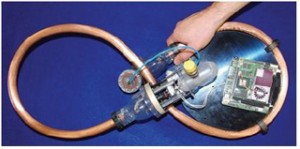Last October, a U.S. patent was issued for a device developed by researchers affiliated with the Center for Compact and Efficient Fluid Power. The device, a free piston engine compressor, directly converts hydrocarbon fuel to compressed air and can be used to power new portable technologies that use pneumatic actuators.
“There really wasn’t much guidance out there for an engine and compressor combined into one thing,” said Eric Barth, a professor at Vanderbilt University who helped develop the device. “All previous examples of engines that would then be linked to serve that function were separate modules that could be bolted together.”
Replacing traditional battery-powered electric air compressors with this new power supply allows for further development in applications such as un-tethered robotics, portable hand tools and more. The device provides an energy density up to four times that of a system actuated by a battery powered motor, which would allow un-tethered devices to be lighter and operate for longer periods.
 “It’s an interesting engine cycle because it’s not a two-stroke engine and it’s not a four-stroke engine, but it has two strokes to it,” said Barth. “It’s like the intake and compression stroke of a normal four-stroke engine is done by injecting high pressure air and fuel very quickly and combusting it.”
“It’s an interesting engine cycle because it’s not a two-stroke engine and it’s not a four-stroke engine, but it has two strokes to it,” said Barth. “It’s like the intake and compression stroke of a normal four-stroke engine is done by injecting high pressure air and fuel very quickly and combusting it.”
The second prototype of the device was able to achieve a measured efficiency ranging from 3.45% to 6.63% and power output ranging from 9.6 W to 17.9 W. Its efficiency was improved to 4.4% to 8.1% with pressure output ranging from 380 kPa to 720 kPa with the addition of virtual-cam control. The third prototype was able to increase this to 1.2 MPa thanks to design changes in the compressor head check valve and inertance nozzle.
The device reduces vibrations by combining a figure eight design and a novel “liquid piston” trapped between elastic diaphragms. This design exploits the fluid-hammer effect, a surge in pressure caused when a fluid in motion is suddenly forced to stop or change direction. Using this configuration and operation the engine does not require an idle and can provide power on demand without wasting fuel.
“The liquid piston aspect of the device allows you to do a balancing of the engine,” said Barth. “You essentially have a one-cylinder engine that you can balance because you can have different parts of the ‘piston,’ which is the liquid section, moving in one direction and in other sections moving in the opposite direction.”
Check out this related article on free piston engines: http://www.mobilehydraulictips.com/ccefp-update-hydraulics-free-piston-engines/

Leave a Reply